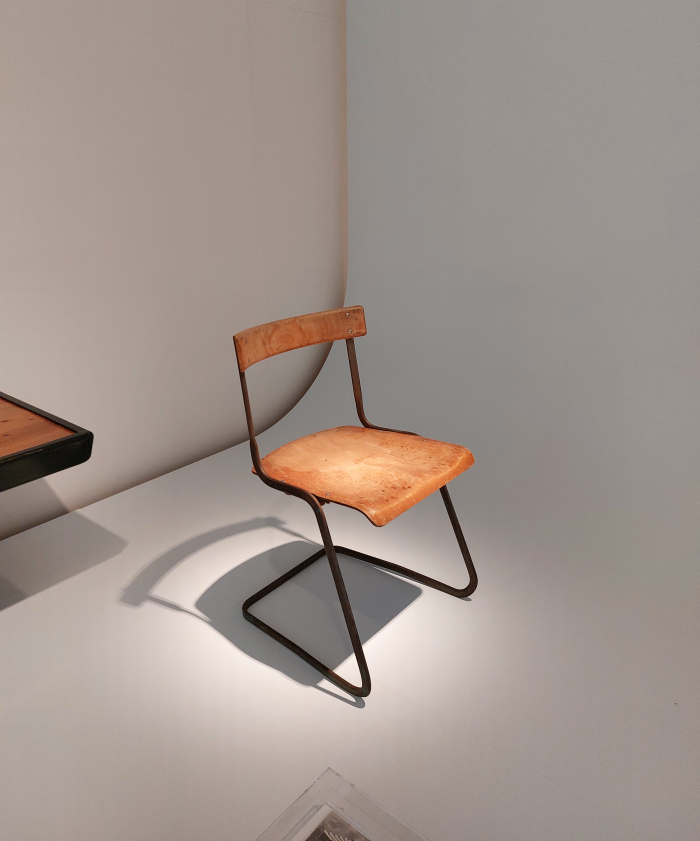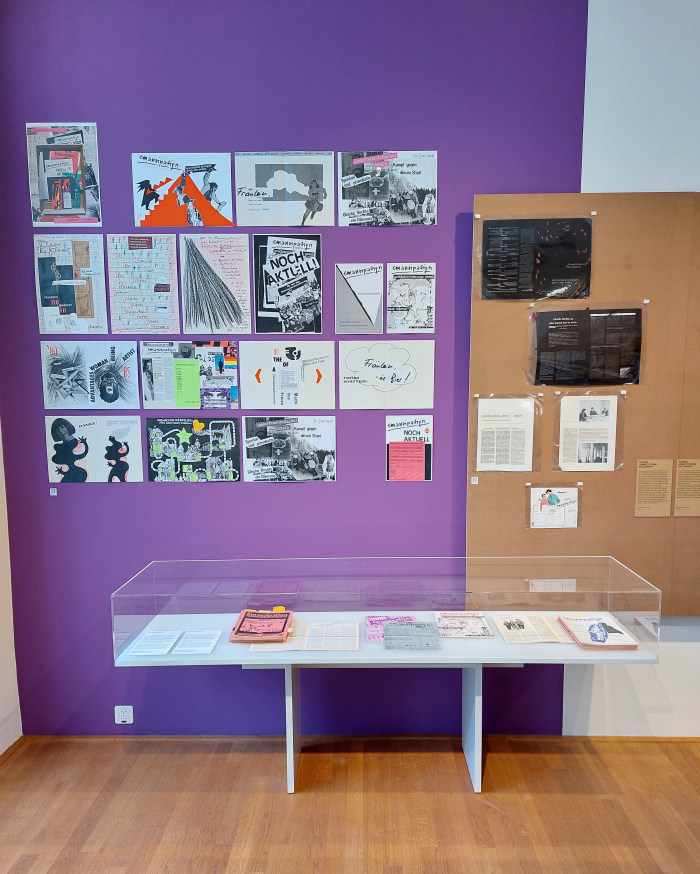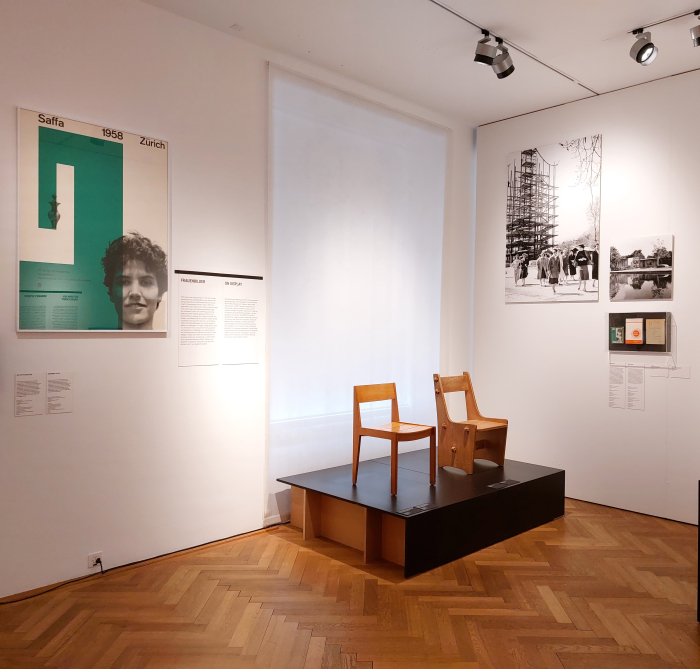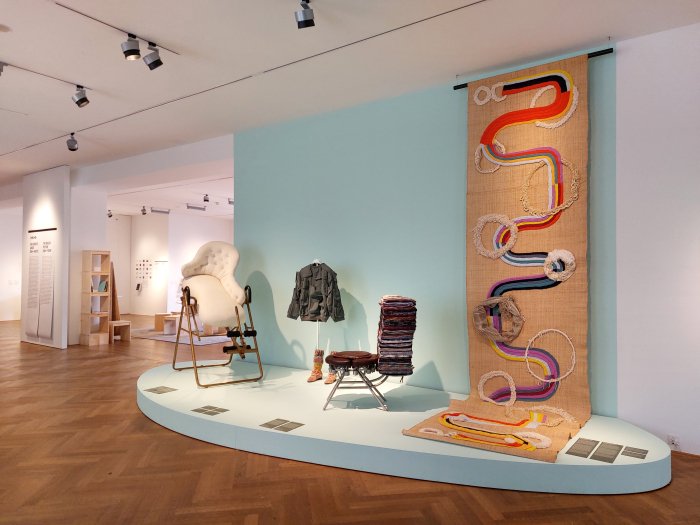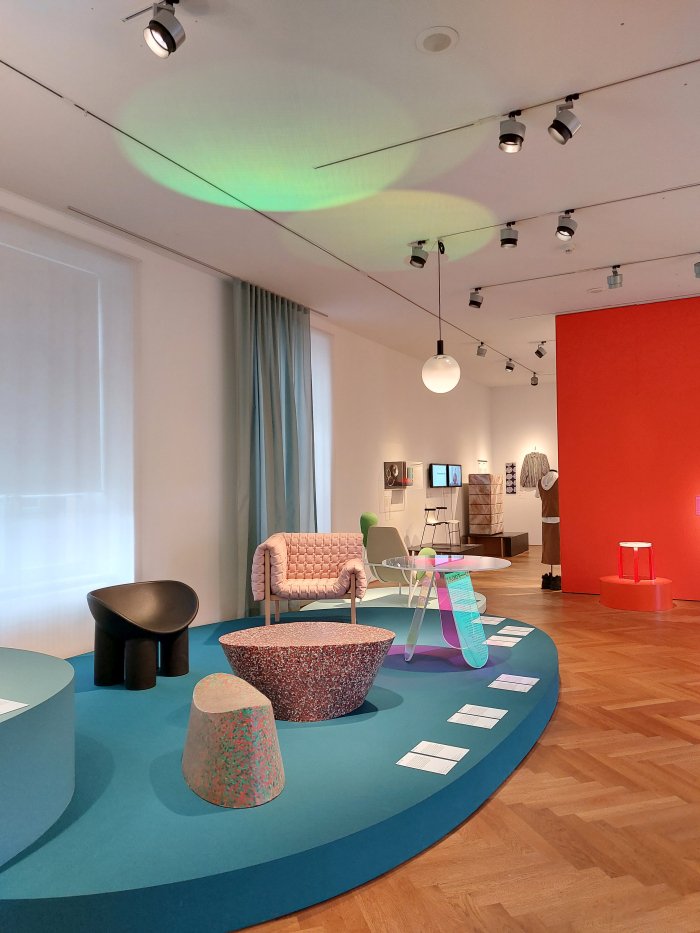What is the popular understanding of the contribution of women to the mural of design (hi)story?
Exactly.
Thus, and with very good reason, and a degree of necessity, urgency even, the Gewerbemuseum Winterthur invite us all to consider The Bigger Picture.......
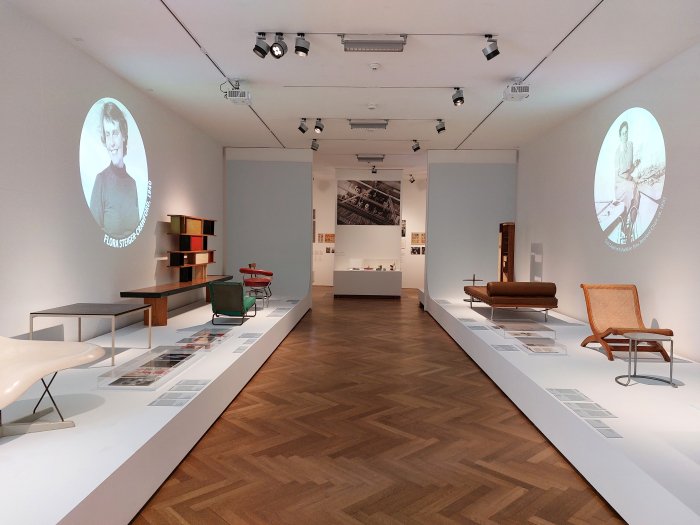
As an exhibtion The Bigger Picture: Design – Women – Society is based on, essentially is, the Vitra Design Museum's exhibition Here We Are! Women in Design 1900 – Today, but is not exactly the same: (most of) all that which was presented in Weil am Rhein is still on show in the Gewerbemuseum Winterthur, and the exhibition still takes you on a journey through a century and half of the myriad subjects of 'women and design': still, for example, explores primarily the frameworks, conventions, restrictions, prejudices et al that have defined and shaped and controlled the myriad subjects of 'women and design' since the later half of the 19th century; still, for example, forces one to pose, while itself never directly approaching, if indicating towards, an answer to, the question why having started out as essentially genderless design became popularly understood as being a male dominion; still, for example, discusses how in more recent decades the visibility of women in historical and contemporary design has started to improve, if imperceptibly at the popularly understood professional level as represented by manufacturers portfolios. Still indicates the amount of work to be done.
But all that has been extended and expanded by the inclusion of a very strong Swiss focus, the addition of a Swiss layer to and throughout the discussions and explorations. And that not only very pleasingly and very satisfyingly, but effortlessly.
Thus, for example, whereas in the opening chapter covering the late 19th/early 20th centuries Gunta Stölzl, the first and only full-time female Meister at the Bauhauses, was represented in Weil am Rhein by but a wall hanging from 1923, in Winterthur you can not only enjoy that wall hanging but also enjoy a collection of samples of clothing, furnishing and curtain fabrics developed by Stölzl in Zürich between the 1930s and 1960s in context of her hand-weaving business Flora, for clients as varied as, for example, the furniture and interior textile concerns Wohnbedarf and Simmen, for various public architecture and interior design commissions, both realised and unrealised, or for the Grieder clothing company for whom in the 1930s Stölzl created what is referred to as a woollen "sport fashion fabric", which sounds suspiciously like 1930s athletic ware. And which while by no means the full Gunta Stölzl, is very clearly not only a much broader approach to Stölzl's work than one is normally exposed to, a presentation that takes Stölzl's biography and sphere of influence and relevance beyond the restricted confines of the Bauhaus' Weaving Workshops to which it is normally so steadfastly tied, but which also allows for access to alternative perspectives on the development of furniture and interiors in post-War Switzerland, alternative perspectives on the biographies of key protagonists in the development of furniture and interiors in post-War Switzerland, than is normally allowed by established narratives.
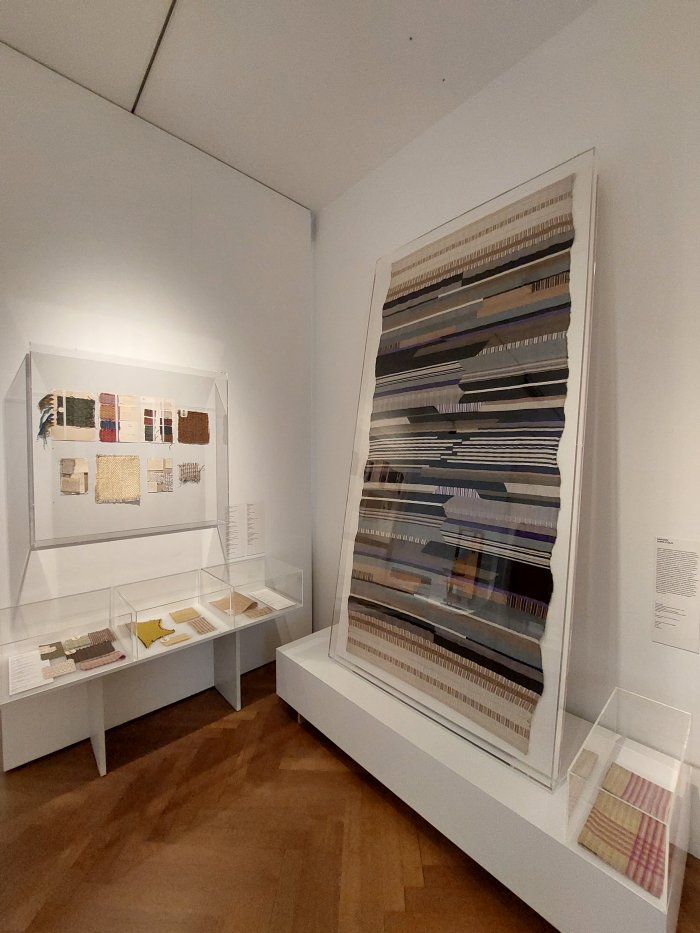
Similarly, the section on female researchers, mediators and lecturers while still introducing the work of the Austro-German designer Herta-Maria Witzemann has been extended and expanded in Winterthur by the Swiss architect, author and lecturer Verena Huber; the section In The Media with its focus on representations of female creatives, female positions, females, has been expanded through Swiss examples, including the addition of a 1928 article from the Swiss architecture magazine Das Werk on an apartment complex in Zurich specifically for single women designed by Lux Greyer, one of the first female freelance architects in Switzerland, and an apartment complex as a very nice reminder of the changing social status of women in Europe following the demographic changes of the Great War, changes, inarguably, that were forced upon a male European society that otherwise wouldn't have, and demographic changes of a same same but different type to our own age and thus an apartment complex that could indicate a same same but different solution to our contemporary challenges. And whose "kitchens furnished according to Taylorist principles", reminds of the optimisation diktat of the period. Another very informative comparison to our optimisation obsessed own age. Or the section Designing Protest, with its focus on the graphics and identities employed over the decades by Women's Rights movements, and which has been joined in Winterthur by Designing Protest 2.0 with its focus on (primarily) 21st century Swiss graphics and identities including a poster, a call to action, by Agnes Weber for the 1991 Frauenstreik, Female Strike, an event repeated in 2019, or the visualisation of female representation in the Swiss National Council, the lower House of Parliament, between 1971 and 2019 by Bern based studio Hahn + Zimmermann, 1971 being a not randomly selected year, but namely that year in which Swiss women were granted franchise. As the last in Europe. By a huge margin, as a poster in The Bigger Picture excellently reinforces.
Or the expansion of the section Making a Mark, an exploration of entrepreneurs and their businesses, those commercial platforms that make and sell design; a relatively brief section in the Vitra Design Museum that in the Gewerbemuseum takes on a much larger role, arguably a difference of scale reflective of the contrast between the Gewerbe, industry, origins of the Winterthur museum and the Design, design, origins the Weil am Rhein museum. And a greater focus with a strong Swiss dialect, including brief introductions to the works and careers of, for example, Margrit Linck, the first woman in Switzerland to open her own ceramics studio; Doris Lehni Quarella who was so influential in the development, formally and commercially, of the metal furniture manufacturer Lehni; or the interior architect Rosmarie Baltensweiler, who together with her husband, the electrical engineer Rico, co-founded, designed for and defined, the Luzern based lighting manufacturer Baltensweiler.
The primary Swiss focus however is be found in the expansion of the chapter The Bigger Picture 1990 - Today. A chapter title from Here We Are! but which the Gewerbemuseum Winterthur have not only made their exhibition title, but in many regards, their focus.
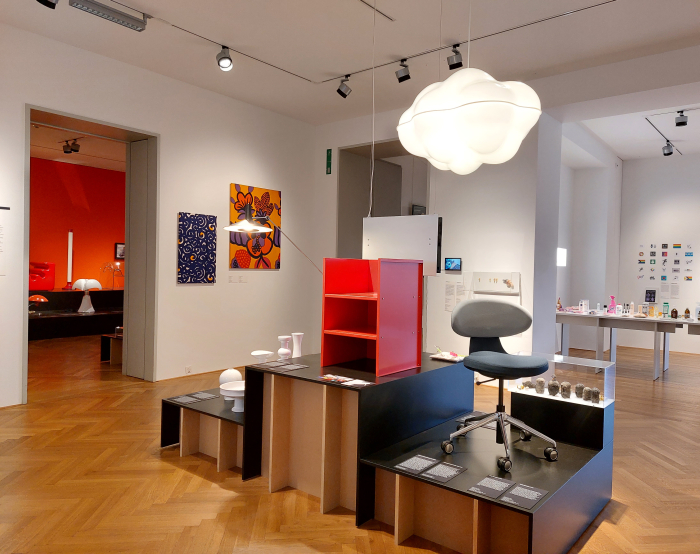
An expansion undertaken on the one hand within the sections Design and Research, Interfaces and Working on Progress through the addition of projects by contemporary Swiss designers, including, for example, and amongst many others, Sarah Harbarth who through her company Kuori develops innovative biomaterials as alternatives to synthetic plastics; game designer and developer and publisher Philomena Schwab from Stray Fawn Studio, who is also a co-initiator of Zürich's Swiss Game Hub, a non-profit organisation which in addition to being a platform for exchange amongst game designers also offers co-working space; or textile designer Selina Reiterer whose on-going project Sonic Silver, in cooperation with artist Oliver Maklott, has developed a PET material coated with a nano-layer of silver thereby bequeathing it an electro-conductivity with all the possibilities that opens.
An expansion undertaken on the other hand via the addition to the chapter of the section Diversity and Inclusion, a section that includes, for example, the installation Gender Salon by Larissa Holaschke with its copious collection of everyday consumer goods not only very obviously pitched through their packaging at specific genders, but which tend to perpetuate and reinforce traditional gender stereotypes and understandings, and that, arguably, actively; and also includes a discussion on gendering in language, in writing and for all in pictograms, the latter taking the discussion beyond gender and featuring pictograms that reject conventional segregated representations and fully embrace the diversity and inclusion of the section title. And which in doing so gently reminds you that gender isn't the only context in which design, the products of design and the (hi)story of design needs to be reassessed and repositioned, reminds you that there is a lot more than just the myriad subjects of 'women and design' to be reconsidered.
An expansion on the all to rare, and thus all the more valuable, third hand through a discussion on the magazine Emanzipation, a feminist magazine published in Switzerland between 1975 and 1996 and that as one of the earliest, and, arguably, longest running, platforms for feminist exchange and discourse in Switzerland; and which in The Bigger Picture is very neatly sat alongside, and thereby in discourse with, the Basel based online feminist design education platform Futuress.
And an expansion that, in conjunction with the projects and protagonists and discussions carried over from the final chapter of the original Vitra Design Museum presentation, reinforces the position, the belief, the confidence of the final chapter that we can return to a place where design is genderless, return to a time before women in design had to announce Here We Are!!!
But that won't happen by itself.
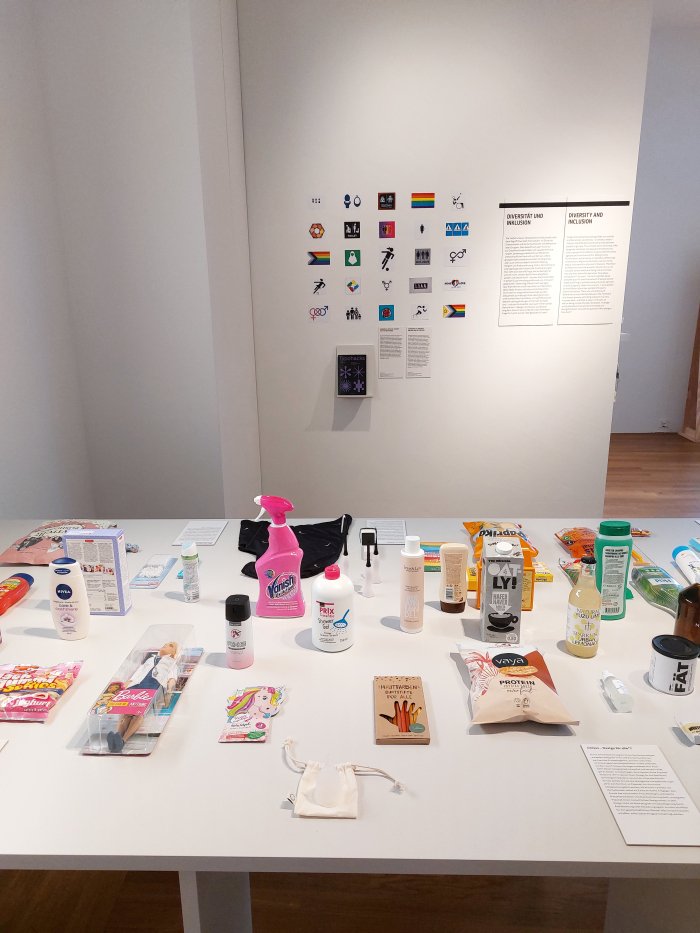
Every bit as accessible, informative and entertaining as Here We Are!, The Bigger Picture also equally skilfully avoids both the risk of falling into a senseless and meaningless comparison of male and female designers, or the ghettoisation of placing the female protagonists' gender as being their defining and most interesting characteristic, and concentrates fully on discussing the myriad subjects of 'women and design' since the late 19th century through the works of the represented protagonists; and also discussing the myriad subjects of 'women and society' and 'design and society' that are inherent in that narrative, inherent in that journey since the late 19th century, and which helps both Here We Are! and The Bigger Picture so elegantly reinforce the inextricable links between design and society. That other bigger picture we all need to view more openly.
A narrative that by necessity can be but an introduction, one that you must take up and develop yourself later, The Bigger Picture simply can't do all the work for you. But does give you more than enough to work with. And no excuses not to.
And a narrative told, as in Weil am Rhein, via a pleasingly varied mix of protagonists well-known and lesser well-known, and a varied mix of objects well-known and lesser well-known, if a somewhat different mix of objects and protagonists; the Gewerbemuseum Winterthur is, if we've judged correctly, a smaller space than the Vitra Design Museum, certainly not substantially larger, and so when new things come others must go, and, and unless we missed them, which is always probable and possible, The Bigger Picture presents, for example, a much smaller presentation of the work of Gertrud Kleinhempel and finds no space for, for example, Christa Petroff-Bohne, Lina Bo Bardi or two research projects, one seeking to allow UK designer Jane Dillon to rediscover her place on design's helix, the other Dizajnerice by Zagreb based collective Oaza into female designers active between 1930 and 1980 in the contemporary Croatia. And despite the very real shame of such reductions and absences, for all the absence of the research projects, absences which underscore the need for the Vitra Design Museum to finally get round to writing a Here We Are! catalogue!!!; the new additions, the new ways in which the space is employed, is very much to be welcomed.
New additions which for all allow The Bigger Picture to enable you to question not only your perspective on the (hi)story of design, and the reasons for that perspective, but for all to question your perspective on the (hi)story of design in and from Switzerland, and the reasons for that perspective. To question why so few females are visible on the mural before you. And to better appreciate why that questioning is important. Necessary. Urgent even.
And new additions which allows The Bigger Picture to stand, we'd argue as a near textbook example for all museums taking on a touring exhibtion: don't just expand it with items out your collection, but expand it through a focus on your region and/or the specifics of your local (hi)stories. The narrative the original exhibition tells will often be very general, but that general narrative is invariably mirrored in national, local, narratives, and telling those national, local, narratives is not only important, but can, as The Bigger Picture ably demonstrates, also help expand and deepen appreciations of the global narrative.
Or put another way, just imagine if over time Here We Are! became numerous The Bigger Pictures. Wouldn't that be an excellent resource. And enable the realisation of a more meaningful, and more joyful, mural of design (hi)story. But that said, no pressure on those museums who will be presenting Here We are! in the coming years, for its tour is very much ongoing.
As is, must, the increasing appreciation of the need to realign the popular perspective on the (hi)story of design, the need to adjust our view across the (hi)story of design, and that not just in terms of gender but through correcting all our existing skews and blind-spots, and doing all we can as a global society to try to ensure that future skews and blind-spots simply cannot arise. In design or in society.
The Bigger Picture: Design – Women – Society is scheduled to run at Gewerbemuseum Winterthur, Kirchplatz 14, 8400 Winterthur until Sunday May 14th.
Full information, including information on opening times, ticket prices, current hygiene rules and the accompanying fringe programme can be found at www.gewerbemuseum.ch/the-bigger-picture
